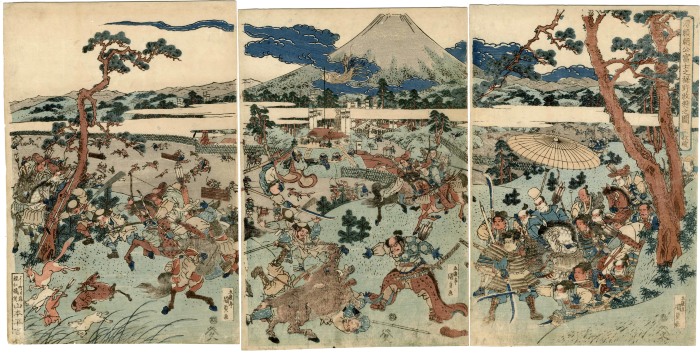Utagawa Kunisada (歌川国貞) / Toyokuni III (三代豊国) (artist 1786 – 01/12/1865)
Minamoto Yoritomo's hunting party in the foothills below Mt. Fuji - Minamoto Yoritomo kō Fuji no susono makigari no zu (源頼朝公富士之裾野牧狩之図)
ca 1814
31.5 in x 15.5 in (Overall dimensions) Japanese color woodblock print
Signed: Gototei Kunisada ga
五渡亭国貞画
Publisher: Yamamotoya Heikichi
Marks 595 - seal 04-007
Censor seal: kiwame
Waseda University Library
Museum of Fine Arts, Boston
Museum of Fine Arts, Boston - 19th c. tsuba showing same encounter In Japanese Treasure Tales by Kumasaku Tomita and published by Yamanaka & Company in 1906, on pages 16-17 it says: "Yoritomo - founder of the Shogunate, and himself the first Shogun - settled in Kamakura near Yedo, in 1192 A.D. In the following May, he invited all the great Daimios to meet him on a certain day at the base of Fujiyama, for a great hunting expedition. In obedience to this invitation a great party - popularly said to number ten thousand (the Japanese are very fond of numbers, especially thousands) Daimios and their suites assembled for the purpose under innumerable tents a unique assembly in the history of Japan. On the third day of the hunt, a wild boar, of unusual size and ferocity, although already wounded by four or five arrow shots, dashed towards the Shogun, who, seeing his danger, called to a brave samurai named Shiro Nitta, who was waiting by, to kill the infuriated beast. Without a moment's hesitation, Shiro, as the boar rushed past him, jumped straight from his horse on to the boar's back, holding on with one hand to the creature's tail as if it were a bridle, while with the other he drew his wakizashi (shorter of the two swords worn by gentlemen ) and stabbed the boar deeply five or six times. With a piteous moan the poor beast expired, not falling however, since by the impetus of its desperate flight, its legs remained stuck firmly some four or five inches in the soft ground. Yoritomo, conceiving that he owed his life to Shiro's bravery and resource, as a recognition thereof, endowed him with an estate of five hundred cho [about 150 acres]."
****
"In 1193, when the great warrior Yoritomo gave a hunting party at the foot of Mount Fuji, a boar suddenly broke cover and,wounded and maddened, headed straight at the hunters, too fast to be hit with their arrows. In an instant the warrior Nitan-no-Shiro Yadatsune sprang from Yoritomo's bodyguard and, casting aside his bow and arrows, and leaping on his horse, he made straight for the boar, which turned to attack him. Like a flash Nitan leaped on the back of the beast, with his own back to the animal's head. Grasping the tail, Nitan clung to the speeding animal until he found a chance to draw his dagger and stab him to death. Thereupon, so it is said, he received an ovation "so great as to shake the surrounding hills." "
Quoted from: The Asian Animal Zodiac by Ruth Q. Sun.
****
Yoritomo appears on the back of a dappled horse in the right-hand panel. He is protected by both a crowd of warriors, but also by the large yellow umbrella. In the middle panel Nitan-no-Shirō Yadatsune is about to take on the boar.
If you use the enlarging tool you will see that in the middle ground of center and left-hand panels there is a fenced off field that is used as a hunting arena where archers are going after deer, foxes and other animals.
****
Yoritomo's sasarindō crest appears prominently on the war curtains and the banners of his encampment seen in the center panel in the middle- to background.
****
There is another copy of this triptych in the Worcester Art Museum.
****
Illustrated, according to the Museum of Fine Arts in Boston, in the catalog of the National Museum of Japanese HIstory in Nishiki-e wa ika ni tsukurareta ka (錦絵はいかにつくられたか or 'How nishiki-e prints were made'), 2009, #61.
warrior prints (musha-e - 武者絵) (genre)
Yamamotoya Heikichi (山本屋平吉) (publisher)
Historical - Social - Ephemera (genre)
Mount Fuji (富士山) (genre)
Jūnishi (十二支 - 12 signs of the Zodiac) (genre)
